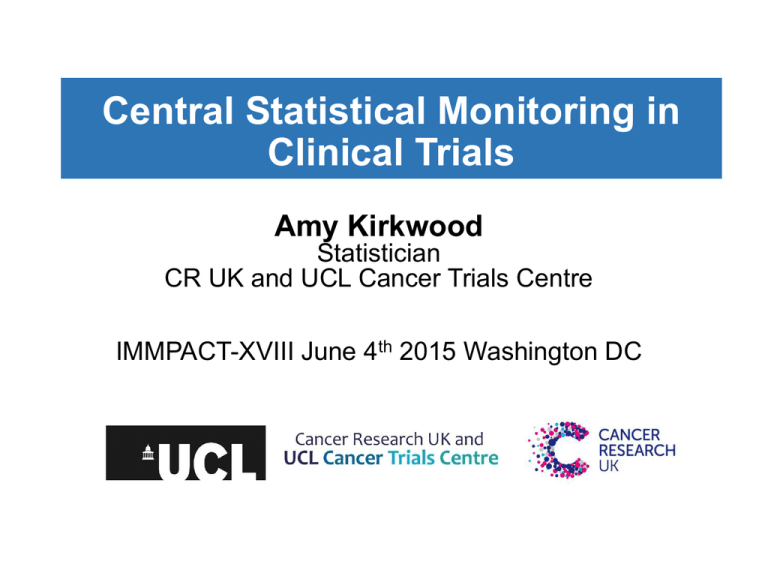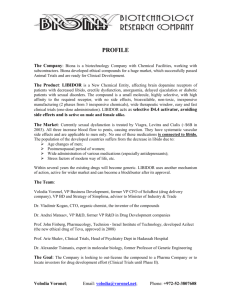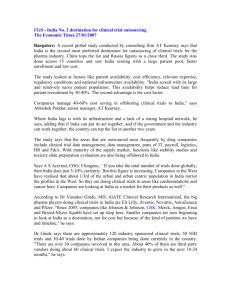Central Statistical Monitoring in Clinical Trials
advertisement

Central Statistical Monitoring in Clinical Trials Amy Kirkwood Statistician CR UK and UCL Cancer Trials Centre IMMPACT-XVIII June 4th 2015 Washington DC Central Statistical Monitoring in Clinical Trials • The ideas behind central statistical monitoring (CSM) • Examples of the techniques we used and what we found in our trials • What we are doing at our centre and plans for the future • Other research that has been published since we started looking into CSM • Further research that needs to be done. The CR UK and UCL Cancer Trials Centre • We run academic clinical trials, none of which are licensing studies. • Patients do not receive financial compensation and centres receive no direct financial benefits for taking part in any of our studies. • Until 2014 all of our trials collected data using paper CRFs, but we are now moving into eCRFs • Our databases have minimal in-built validation checks. • We use a risk based approach to monitoring as recommended by the MHRA (Medicines and Healthcare Products Regulatory Agency who govern UK IMP trials). • On-site monitoring visits will focus on things like drug accountability, lab monitoring, consent and in some cases source data verification (SDV). Source Data Verification (SDV) • The aim of SDV is to look for three things: • Data errors • Procedural errors • Fraud • On-site SDV is a common and expensive activity with little evidence that it is worthwhile. • Morrison et al (2011) surveyed trialists: • 77% always performed onsite monitoring • At on site monitoring visits SDV was “always performed” in 74% • Bakobaki at al (2012) looked at errors found during monitoring visits: • 28% could have been found during data analysis • 67% through centralised processes. • Sheetz et al (2014) looked at SDV monitoring in 1168 phase I-IV trials: • • 3.7% of eCRF data was corrected 1.1% through SDV. • Tudor-Smith (2012) compared data with 100% SDV to that with unverified data. • • • Majority of SDV findings were random transcription errors. No impact on main conclusions. SDV failed to find 4 ineligible patients. • Grimes (2005) GCP guidelines point out that SDV will not detect errors which also occur in the source data. Central Statistical Monitoring in Central Statistical Monitoring Clinical Trials • What if we could use statistical methods to look for these things at the co-ordinating centre? • Would save time on site visits • Could spend this time on staff training and other activities which can not be performed remotely. • Various authors have suggested methods for this sort of centralised statistical monitoring but few had applied them to real trials or developed programs to run them. Published papers on CSM Paper Subject Buyse et al. The role of the biostatistics in the prevention, detection and treatment of fraud in clinical trials. Stat med 1999 • • Definitions, prevalence, prevention and impact of fraud in clinical trials. Statistical Monitoring techniques suggested. Baigent et al. Ensuring trial validity by data quality assurance methods. Clin trials 2008. • • Taxonomy of errors in clinical trials Suggested monitoring methods. Evans SJW. Statistical aspects of the detection of fraud. In Lock S, Wells F (eds). (2nd edition). BMJ Publishing group, London 1996, Fraud and misconduct in Biomedical Research pp 22 6 - 39 • Suggestions for methods of detecting fraud in clinical trial data. Taylor et al. Statistical techniques to detect fraud and other data iregularitires in clinical questionnaire data. Drug inf J 2002. • Developed and used statistical techniques to detect centres which may have fraudulent questionnaire data. Al-Marzouki S et al. Are these data real? Statistical methods for the detection of data fabrication in clinical trials. BMJ Vol 221 July 2005 • Used comparisons of means, variances and digit preference to compare two clinical trials. O’Kelly M. Using statistical techniques to detect fraud: a test case. Pharm Stat. 2004, 3: 237 - 46 • Looked for centres containing fraudulent depression rating scale data by studying the means and correlation structure. Bailey KR. Detecting fabrication of data in a multicentre collaborative animal study. Controlled clinical trials 1991; 12: 741-52. • Used statistical methods to detect falsified data in an animal study. Central Statistical Monitoring in Central Statistical Monitoring Clinical Trials • We have developed a suite of programs in R (a programming language) which will perform the most common checks, and a few new ones. • These checks are not easily done by the clinical trial database when data are being entered. • The idea was to create output that was simple enough to be interpreted by a non-statistician. • We classified data monitoring at either the trial subject level or the site level. Central ChecksStatistical at the subject Monitoring level • Participant level checks all aim to find recording and data entry errors. • The date checks may also detect fraud if falsified data has been created carelessly. • Procedural errors may be picked up by looking at the order that dates occurred, for example patients treated before randomisation. Outliers may indicate inclusion or exclusion criteria have not been followed. Central Checks Statistical at the centre Monitoring level • These checks aim to flag sites discrepant from the rest by looking for unusual data patterns. • These mostly aim to detect fraud or procedural errors but could also pick up data errors. Examples of centre level checks: Central Statistical Monitoring Digit preference and rounding • The distribution of the leading digits (1-9) in each site was compared with the distribution of the leading digits in all the other sites put together. Digit 1 2 3 4 5 6 7 8 9 p-value: Site frequency Site percent All other frequency 344 33.05 8419 159 15.27 4048 181 17.39 3500 100 9.61 3201 73 7.01 1881 60 5.76 1430 53 5.09 1242 35 3.36 1134 36 3.46 1216 0.00277738 All other percentage 32.29 15.53 13.42 12.28 7.21 5.49 4.76 4.35 4.66 • Rounding can be checked in a similar way (using the last digit rather than the first) or graphically. Examples ofStatistical centre levelMonitoring checks: Inliers Central 10 15 20 25 -1.0 0 10 20 30 40 50 Index Site: 25 ( 10 patients ) Site: 27 ( 6 patients ) 2 3 4 Site: 17 Index 5 6 Site: 17 ( 11 patients ) ( 10 patients ) 1 0 0 Site: 30 ( 31 patients ) -1 log d -2 -3 -3 -4 0.0 2 4 6 8 10 1 Index 2 3 4 5 6 -5 -5 -1.0 -4 log d -0.6 log d 1.0 -1 0.2 -0.2 log d 0.2 -0.2 -0.6 log d 0.6 1 Index 1 0 5 10 15 20 25 30 2 Index -2 5 -0.5 log d 0.0 • These are automatically circled in red. -1.0 log d 0.0 1.0 0.0 0.5 1.0 • Site: The program picks out multivariate inliers 24 ( 6 patients ) (participants which fall close to the mean on several variables) which could indicate falsified data. Site: 20 ( 49 patients ) -1.0 log d Site: 19 ( 25 patients ) 4 Index 6 Index 8 10 2 4 6 8 10 Index • Subjects which appear too similar to the rest of the data within a site are output. Site: 33 ( 11 patients ) Site: 34 ( 8 patients ) 0.5 1.0 Site: 31 ( 28 patients ) 0.5 0.0 -1.0 log d 0.0 -0.5 -1.0 log d 0.0 -1.0 log d • Both plots and listings should be checked as multiple inliers within one site may not be picked out as extreme. Examples of centre level checks: Central Statistical Monitoring Correlation checks • This method examines whether a site appears to have a different correlation structure (in several variables) from the other centres Site CHR (72patients) p=0.343 Site 999 (40patients) • Values for each variable may be easy enough to falsify but the way they interact with each other may be more difficult. p=<0.001 Site RMA (21patients) • As with the inlier checks, both plots and p-values should be considered. p=0.426 Site Site COO CHR (12patients) (72patients) p=0.963 p=0.9742 Site Site QEH 999(36patients) (10patients) p=0.492 p=0.026 Site SiteUCL RMA (18patients) (21patients) p=0.021 p=0.6142 25 24 23 • Colours are used to automatically flag patients with high variance (may indicate data errors; coloured in red/pink) and low variance (possible fraud; coloured in blue) 22 • It looks at the within patient variability. index - ordered by site and patient • The variance checker can be used on variables with repeated measurements. For example blood values at each cycle of chemotherapy. 26 Examples of centre level checks: Central Statistical Monitoring Variance checks 12 65 125 193 261 329 397 465 533 601 669 737 805 873 Platelets Examples of centre level checks: Central Statistical Monitoring Adverse Event rates • Under-reporting of AEs is a potential problem. SAE rate vs number of patients in a site • How many SAEs in total has the site recorded? • How does the site rate compare to the overall rate? • Program could be adapted to look at incident reports; high rates, with low numbers of patients may be concerning. 0.10 0.05 0.00 • Other points to consider when assessing the output: Rate • All sites with zero SAEs, plus the lowest 10% of rates are shown as black squares. 0.15 • SAE (severe adverse event) rates for each site are calculated as the number of patients with an SAE divided by the number of patients and the time in the trial. 0 10 20 30 40 Number of patients 50 60 70 Examples of centre level checks: Central Statistical Monitoring Comparisons of means • We looked at several ways of comparing the means of many variables within a site at once. Chernoff face plots by site 1 2 3 • Other authors had suggestedChernoff face 9 plots 11 by site 12 Chernoff face plots or Star plots. 1 2 3 • We found both to be difficult to interpret. 4 9 11 12 14 Index Index Index Index • Right is a Chernoff for a 24 21 face 22 plot 23 single CRF (preIndex chemotherapy Index Index Index lab values). 30 32 33 • Each variable controls one of Index Index Index15 different facial features. 43 44 45 Index 5 Index 54 58 59 60 Index Index Index Index 8 14 15 16 17 19 Index Index Index Index Index 7 8 24 26 27 28 29 Index Index Index Index Index Index Index Index 15 30 32 IndexIndex Index 43 26 Index Index 54 44 Index 16 17 19 36 37 41 42 IndexIndex Index Index Index Index Index Index Index 27 45 2846 47 29 48 51 53 Index Index Index Index 63 69 71 72 Index Index Index Index Index 79 81 82 83 53 Index Index Index Index Index Index Index 33 Index Index 58 36 59 37 Index Index 73 Index 7 23 Index Index Index 6 22 Index Index 6 5 21 35 46 Index 4 47 Index Index Index 88 Index Index 63 Index 76 48 Index Index Index 69 Index Index 60 41 75 Index 35 Index Index Index Index 78 51 Index Index Index 71 Index Index 42 Index Index 72 Index Central Statistical Findings in ourMonitoring trials Trial Findings Trial 1: Phase III lung cancer trial, data cleaned and published. • Some date errors which had not been detected. • Outliers which were possibly errors detected (not used in the analysis). • Some patients treated before randomisation (this was known). • One site with a very low rate of SAEs which may have been queried. • Some failures in the centre level checks but no concerns that data had been falsified. Trial 2: Phase III lung cancer trial; in follow-up • More date errors detected and more possible outliers. • Some failures in the centre level checks but no concerns that data had been falsified. Trial 3: A phase III Biliary tract cancer trial; data cleaned and published –errors added to test the programs. • False data could be detected when it fitted the assumptions of the programs. • Data created by an independent statistician was picked up as anomalous by several programs. How is this being put into practice at our Central Statistical Monitoring CTU? • Tests to apply will be chosen based on the trial size. • Data will be checked at appropriate regular intervals. • After set up (by the trial statistician), the programs can be run automatically. • Potential data errors (dates and outliers) would be discussed with the data manager/trial co-ordinator. • The need for additional data reviews and or monitoring visits would be discussed with the relevant trial staff for sites where data appear to show signs of irregularities. Papers published since 2012 Paper Subject George SL & Buyse M. Data fraud in clinical trials. Clin Investig (Lond). 2015; 5(2): 161-173. • A summary of fraud cases and methods of detection. • • Used a linear effects mixed model on continuous data to detect location differences between each centre and all other centres. Two examples its use in clinical trials. Edwards P et al. Central and statistical data monitoring in the Clinical Randomisation of an Antifibrinolytic in Significant Haemorrhage (CRASH-2) trial. Clin Trials. 2013 Dec 17;11(3):336-343. • • • Monitored a few key variables centrally. Findings could trigger on-site Procedural errors found which could be corrected. Pogue JM et al. Central statistical monitoring: detecting fraud in clinical trials. Clin Trials 2013 Apr;10(2):225-35. • Built models to detect fraud in cardiovascular trials. Venet D et al. A statistical approach to central monitoring of data quality in clinical trials. Clin Trials 2012 Dec;9(6):705-13. • Cluepoints software used to detect fraud. Valdes-Marquez E et al. Central statistical monitoring in multicentre clinical trials: developing statistical approaches for analysing key risk indicators. From 2nd Clinical Trials • Used Key risk indicators (AE reporting, Study treatment duration, blood results given as examples) to assess site performance. Desmet L et al. Linear mixed-effects models for central statistical monitoring of multicenter clinical trials. Stat Med 2014 30;33(30):5265-79. Methodology Conference: Methodology Matters Edinburgh, UK. 18-19 November 2013 Examples of the use of CSM • Vernet et al – a paper on the work at Cluepoints. • Company offering CSM to pharma companies, CROs and academic started by Marc Buyse. • Applies similar methods to all data in a clinical trial database. • Each test produces a p-value and they analyse these p-values to identify outlying centres. • Centre x (where fraud was known to have occurred) picked out as suspicious with both tests. • Centres D6 and F6, in plot 1 and D1 and E6 on plot 2 are also extreme. Examples of the use of CSM • Pogue et al. • Used data from the POISE trial (where data was known to have been falsified in 9 centres) to develop a model which would pick out these centres. • Used similar methods to those I have described to build risk scores (3 variables in each model). • The risk scores could discriminate between fraudulent and “validated” centres well (area under the ROC curve 0.90-0.95). • Risk scores were validated on a similar clinical trial which had on-site monitoring and no falsified data had been reported. • False positive rates were low (similar or lower to those in the POISE trial) • Method has not been validated against another trial with fraud. • May only work in trials in this disease area; or with specific variables reported. Central Statistical Monitoring Advantages over SDV • All data could be checked regularly, quickly and cheaply. • Data errors would be detected early, which would reduce the number of queries needed at the time of the final analysis. • Procedural errors are more likely to be detected during the trial (when they can still be corrected). • Every patient could have some form of data monitoring, performed centrally (compared to currently, where only a small percentage of patients might have their data checked manually at an on-site visit). • May pick up anomalies which existed in the source data as well. CentralDisadvantages Statistical Monitoring • Some methods are not reliable when there are few patients in each site (expected). This could particularly be an issue early on. • Programs to find data errors can be used on all trials, but several of the programs for fraud detection would only be applicable to large phase II or phase III studies. • Some methods are somewhat subjective. What other research is needed? • How much does CSM Cost? • Money may be saved in site visits • Costs of implementing the tests and interpreting the results • May more for-cause monitoring visits occur? • How can it validated? • How can we be sure that sites which are not flagged did not contain falsified patients? • TEMPER Trial - Stenning S et al. Update on the temper study: targeted monitoring, prospective evaluation and refinement From 2nd Clinical Trials Methodology Conference: Methodology Matters Edinburgh, UK. 18-19 November 2013 • Matched design; sites flagged for monitoring based on centralised triggers are matched to similar sites (based on size and time recruiting). • Aims to show a 30% difference in the numbers of critical or major findings. Further details Further details on the central statistical monitoring we have looked at in our centre can be found here:






